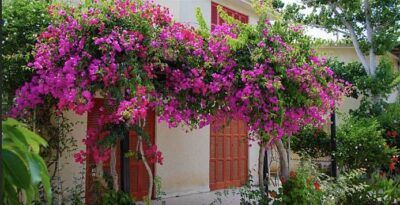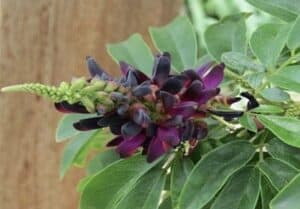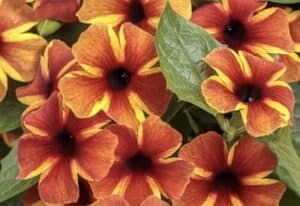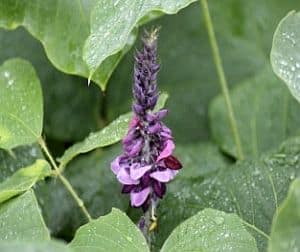(Image above: Bougainvilla)
The Beauty of Southern Vines
26 stunners you should know
Summary of presentation by Glen Laborde, Master Gardener
Types of Vines by support:
Bines – twist their stems around a support.
Vines – that use tendrils and suckers.
Sprawlers – need help to connect
Dan Gill’s rule of lacing shoots, that want to go straight up on trellises: “Always lace shoots laterally”
I. ANNUAL VINES Last for only one season. Little chance of getting out of Control.
A. COOL SEASON
- Sweet pea (Lathyrus odoratus) – Plant early as October for next year. Blooms are usually March-May. Cut stems as long as possible. Make sure seed pack says “fragrant”- strangely some aren’t!!! A dry sunny day is the best time to savor the smells. Smell champs: (Flora Norton, Gwendilone, Lady Grisel, Hamilton, Matucana, Mollie Rilstone, Painted Lady, Black Knight, Dorothy Eckford)
- Nasturtium (Tropaeolum majus) – Colorful and edible. Name means “nose-twister” in Latin – the reaction to tasting the flowers –Seeds and leaves edible too. Are a source of Vitamin C and iron. Used as a pepper substitute in WWII. Plant early spring for summer flowers. Needs to be physically tied or twisted on support – sprawler. Likes full sun and sandy well drained soil. Deadhead for more flowers. Unexpectantly, poorer soil produces more flowers/ a self- seeder.
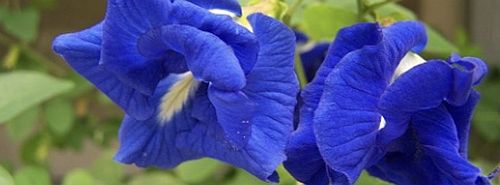
(Image above: Blue Pea Vine, Glen’s favorite)
B. WARM SEASON
- Morning Glory (Ipomoea purpurea) – Loves full sun for blooms. Fertilizing gives more leaves but less bloom
- Cardinal climber (Ipomoea multifida) – pentagon shaped bigger red
- Cypress vine (Ipomoea quamoclit) – Star shaped smaller, red, pink or white
Both have fern-like foliage, from the morning glory family, “hummingbird paradise” - Hyacinth Bean (Dolochos lablab) Pinkish purple blossoms. Interesting reddish-purple seed
Pods. (*Careful-mature and dry beans have high amounts of cyanogenic glycosides –not for eating.) - Clematis – Large showy flowers. Non-aggressive vine, protect from wind, Protect roots with thick loose mulch. Tie the vines in the early stages of development. Spring, summer and fall blooming varieties. Happiest with cool shade at their roots and warm sun on their foliage.
- Black-eyed Susan vine (Thunbergia alata) – In the ground gives “alata blooms”, lol. Continuous bloomer, Full sun gives best results. Heat tolerant, Temperatures below 28 can kill it.
(Images above: [left] Hyacinth Bean; [center] Evergreen Wisteria; [left] Black-Eyed Susan Vine)
II. PERENNIAL VINES– Hardy Evergreen Vines-Become permanent parts of your landscape.
- Confederate Jasmine (Trachelospermun jasminodes) – Sensational fragrance, Pretty glossy leaves. Originally from the Malay Confederacy in Southeast Asia.
- Carolina jessamine (Gelsemium sempervirens) – A wall of yellow flowers. Candy like smell
Careful: (*All parts of the vine are considered poisonous). - Butterfly vine (Mascagnia macroptera) – Spring and then again fall blooms. Seed pods have look like butterflies
- Evergreen Wisteria (Milletia reticulata) – Flowers late spring into fall. Needs strong support as it will get heavy with time. Very drought tolerant
- Passion vines (Passifloras) (Passaflora incarnata) – native purple. Maypop –name because it is late (May) to popup out of the ground or sound when fruit crushed. A NATIVE PLANT. Not overly aggressive. Dies back to ground with a freeze. Fruit size of plumb-wait until falls or skin slightly yellow for ripeness inside. Documented food of Houmas Indians of Terrebonne Parish. Gulf fritillary butterfly food “They don’t like the reds (Passaflora jamesonii) but bees do”- Art Shapiro, UC Davis.
- Coral honeysuckle (Lonicera sempervirens) – Full sun to maximize flowers. Tons of flowers!!!
Likes our alkaline soils. Less invasive than many ornamental vines. A NATIVE PLANT (Dan Gill’s ‘Louisiana Gardener’s Guide” insights: Orangeish ‘Magnifica’ variety – his favorite, “Gold flame” – an actual scented coral Variety).
HARDY DECIDOUS
- Native wisteria, (Wisteria frutescence) – Native alternative to invasive imported Wisteria. “Amethyst Falls” variety-Fragrant and repeat blooms all summer after the spring show. Strong grower but not invasive.
- Chinese wisteria (Wisteria chinensis) – Don’t plant near a tree. Constant trimming to control its aggressive growth 2 weeks of flowers 50 weeks of work trimming sprouts
- Gloriosa lily – (Gloriosa superba) – National flower of Zimbabwe. Needs something to support it, like Nasturtium does. Leaf tips touch and send out tendrils! Deciduous vining perennial- comes back in summer – Avoid intense afternoon sun. Stunning beauty – Has 6 curvy tepals and graceful long stamens. Brought first to Europe from Africa by the second Baron Rothschild. (*All parts very poisonous !!! – care with children or pets!) Foul tasting, but care nonetheless!
- Coral Vine, Rosa de Montana (Antigonon leptopus) – Rugged and doesn’t need special treatment. Don’t fertilize, as you will get rampant growth with less flowering. Pollen makes bad choice for those with allergies. Once it awakens in the spring, growth is very rapid. Flowering in late summer can continue until frost.
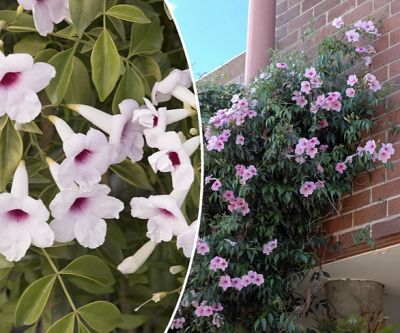
TENDER PERENNIAL (Could die in low 20s temperatures)
(Image right: Pandora Vine)
- Mandevilla, Classic pink “Alice Dupont” – has largest flowers.
- Bougainvillea – provide as much light as possible for optimal flowering (6 hrs. is minimum). Container culture gives most reliable blooming. It is a sprawler – needs support. Don’t do repotting too quickly and if you do, use a slightly larger container elsewise flowering will be reduced until the new container is filled with roots. Bougainvilleas bloom on new growth so, unless necessary, trim after a bloom cycle. Trick of allowing plants to wilt slightly to encourage flowering. Be careful to water as soon as buds appear to protect the plant. *(Plant on back row as thorns are serious!!!) Weeds are an eyesore and they compete with desired plants for nutrients, water, and sunlight. Manage weeds by completely pulling them out of the soil with the roots intact or by using an herbicide. Use preemergent weed blocks such as Preen in planted flower beds on top of mulch and water in. Don’t use Preen when using desired seeds as Preen will prevent them from germinating. Always carefully read herbicide labels following directions. Weed seeds are distributed by birds, on your clothes, and by other animals. Stay on top of any weed problems by removing weeds as soon as you see them.
- Bleeding Heart Vine, Red Bleeding Heart Vine (Clerodendrum speciosum) Clerodendrum- “Chance tree” Linnaeus saw a variety of appearances and uses for “Clerodendra”. The red is a more-cold hardy than the white bleeding-heart vine. Pretty bracts set off the flower
- Rangoon Creeper (Quisqualis indica) Can grow as high as top of 2 story house. Colors change in 3 days, like the Confederate rose -day 1-open white – day 2-pink, day 3-turn red. Different pollinators for different colors. When established can be a showstopper. Has fragrance
- Pandora vine, bower vine (Pandora jasminoides) – From Australia, Vigorous but controllable prune well after flowering. Flowering spring and summer but will spot flowers throughout the year. Some flowering possible in light shade. Glossy foliage makes great backdrop for flowers. Flowers have a delicate fragrance. Hardy in zone 9B.
SEDUCTIVE BUT EVIL
(Images right: [top]Kudzu; [bottom]Poison Ivy)
- Cat’s Claw (Macfadyena unguis cati) – Considered an aggressive invasive that harms other plants by simply covering them, thus depriving them of light and nutrients. They are disliked by those who have to remove them, as they are difficult to dig up and their claws are painful when they pierce the skin. (*“Beware: NEVER plant them in your yard. They are relentless in their growth and very difficult to control. Even if placed in a container, they will eventually escape into the surrounding environment.” ) – Loyola Center for Environmental Communication.
- Trumpet vine (Campsis radicans) – Highly invasive nature, up to 30 feet called “a terror” Can rampantly self-seed. Beware planting close to trees – Shoots arise all over yard – years of problems. A deciduous Louisiana native plant. Careful of roots invading nearby beds described as “evil monster root system”
- Cross vine (Bignonia capreolata) – NATIVE Often bicolor flowers, heavier bloomer. Mostly evergreen, shoots near arise near base- more manageable (*Caution: can get very large).
- Kudzu “the vine that ate the South” – runs rampant over trees, telephone poles, old buildings, and slow-moving children
- “Bush killer vine” (Cayratia japonica) – Planted with trumpet bush and wild grape in competition trials outgrew and covered them both, 4 lower leaves come from a single spot, 1 upper leaf has its own stem. Red shoots in spring give the gardener an advantage in identifying the pest.
- Poison Ivy – “Leaves of 3, let it be”

By Karen Blackburn

